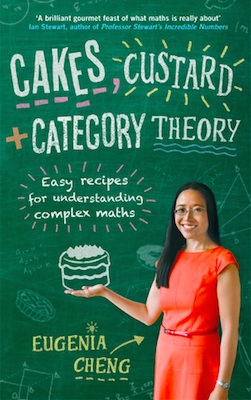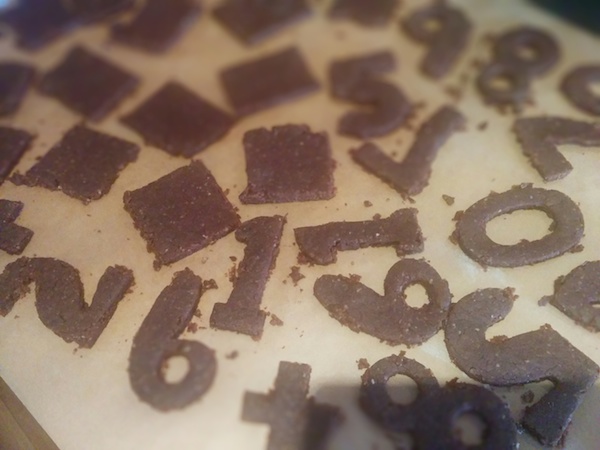
We’ve often mentioned category theorist and occasional media-equation-provider Eugenia Cheng on the site, and she’s now produced a book, Cakes, Custard and Category Theory, which we thought we’d review. In a stupid way.
The book is in two halves: the first is a general introduction to the idea of mathematics and mathematical thinking, and a tour of some fundamental ideas in mathematics such as how to interpret real-world problems, as well as an introduction to group theory and topology. The second half is about category theory. Cheng describes it as being ‘the mathematics of mathematics’, and anyone who knows a bit of category theory will understand what a challenge it is to develop and communicate the necessary ideas in a form understandable to a book audience.
Cheng is well-known for her love of baking and cakes, and is often called on to produce equations relating to foodstuffs (including scones, pizza and donuts), so naturally her book ties this hobby in with her other passion, mathematics. As well as using baking as an analogy for the process of doing maths, Cheng goes one step further and actually includes full recipes for several different foods in her book. The start of each chapter features a recipe, which is then used as an example to illustrate a point she’s making about maths.
Since we’re idiots, we spent an afternoon actually baking and trying out the recipes. I invited round two mathematicians called Sam (you may remember them from our π approximation challenge), along with Aperiodical regular Paul, to have a go at baking the recipes, tasting the results and not in any way letting our ineptitude at making edible food influence our opinion of the book.
The first thing we tried making were Cheng’s gluten free chocolate brownies, from Chapter 1. The idea behind including this recipe is that you need both the ingredients and the method to make a recipe work (in this case, it won’t work if you bake it in one big pan, since it’s gluten-free flour, you have to do small ones), in the same way that maths is about not just the ingredients but also the method. I think. We found it pretty easy, although the baking time given in the recipe wasn’t nearly enough, and we ended up putting them back in the oven twice, because they were basically liquid in the middle, but then the third time we put them back in we forgot because we were busy baking something else, so they ended up horribly overbaked. They’re still quite nice though. 8/10.

Next we tackled the so-called ‘Conference chocolate pudding’: baked one evening after a boozy conference social, these illustrate that if you have the principles of how to bake cakes you can do it, even if you’re wasted, without a recipe. This echoes the way that a mathematician who knows basic principles can derive any mathematical result. It turned out that we didn’t have enough cocoa powder to do this properly, since we already weighed out everything for the other recipes, and so we used vanilla instead for these. They turned out pretty presentable, if a little plain-looking. 7/10.
The book covers an impressive range of maths – not shying away from difficult topics, and jumping from topic to topic with impressive enthusiasm. As well as being split into chapters, practically each paragraph has its own heading, with different topics connecting from one to the other. It’s basically the stuff I’d like someone to have written a book about – from the way mathematicians think, to some of the really interesting pure mathematical concepts that people don’t even find out exist unless they study maths at university.
Our next baking adventure was the Olive Oil Plum Cake, from Chapter 5. While not containing many of the traditional things you’d expect a cake to, like flour, or sugar, this illustrated the chapter on generalisation – once you know what a cake is, you can imagine things which are basically the same as a cake, but aren’t a cake. We managed to successfully bake what we all agreed was not a cake, and while we followed the instructions to the letter and it looked like a cake on exit from the oven, once inverted it quickly became a soggy mass which looked hugely unappetising, despite still being a bit tasty (mostly due to how awesome plums are). Its popularity among the group varied, and we give it 5/10.
We then followed the recipe for Jaffa Cakes, from Chapter 7. The chapter is about axiomatisation, and the recipe simply calls for ‘small round cakes’, ‘marmalade’ and ‘chocolate’. Each of these could have been broken down into more detailed recipes, but the point is that you have to decide what’s an axiom and what can be derived (using a recipe from simpler ingredients). We bought a cuboid cake, and cut it into small round pieces; we also tried, since they do technically count as ‘small round cakes’, using some Eccles cakes, to make Eccles Jaffa cakes. If nothing else good comes from this whole exercise, we at least have that. The main conclusion we came to here is that bought Jaffa cakes are better, although you can’t go far wrong combining cake, marmalade and chocolate. 6/10.
Cheng uses a lot of analogies in the book. Imagine a hedgehog, but where the spines of the hedgehog are analogies. That’s what the book is like. This is good, because they’re well chosen analogies (One of my favourites: pure maths is building things out of basic 2×1 Lego bricks, while in applied maths you get to use the wheels and doors and hinge pieces, so you can do more interesting stuff, but isn’t the pure maths better somehow?), although it does sometimes make for a slightly tangled web (imagine if analogies were woven by spiders). As a result, the amount of time dedicated to explaining the actual mathematics is sometimes slightly less than you’d like. It’s important to get where the maths sits in context, and the analogies are great for that, but sometimes the maths explanations might need reading and re-reading to get an understanding of the way it actually works.
By this stage our energy was flagging and our attention waning, but we pushed on to bake (or rather, not bake) the Raw Chocolate Cookies from Chapter 13. By now the book is starting its explanation of how category theory works, and dealing with the concept of equality and sameness – what things are equal to each other? Numbers can be equal, but there’s a sense in which ‘2+4’ is not the same thing as ‘6’; is homotopy equivalence in topology a form of equality? The analogy here is that the cookies, which might have started as regular cookies, have been made gluten-free, then vegan, then sugar-free, then low-fat, and each step doesn’t take you too far away from the previous cookie, but overall when you’ve finished they’re very different.
Here we struggled with a few things – firstly, some of the ingredients are pretty rare. I now own a jar of coconut oil, which I didn’t before, but struggled to get hold of cocoa butter, which we substituted with… some butter, and we also ran out of cocoa powder halfway through, so we had to add some other stuff, including a bit of flour and some white hot chocolate powder. We basically undid the veganness and the gluten-freeness, and the low-fatness. All of the things we put into these cookies were ingredients you’d normally find in a nice baked product, but somehow all our substitutions and ineptitude culminated in biscuits which looked, and tasted, like dog biscuits. Not even my funky maths cookie cutters could save these. They’re very much not equal to biscuits. 2/10.
The book has a lovely tone – it’s relentlessly positive about maths, the ways in which it can be useful and fascinating, and people’s ability to do and engage with mathematics. It’s also full of friendly anecdotes about Cheng’s own failures and successes, in and out of the kitchen and maths department, and draws the reader in with her enthusiasm and charm. Cake-based metaphors are used even away from the recipes in each chapter – had you noticed that the multiplication table for $\mathbb{Z}_2$ was a Battenberg cake?
We did have one final success story – and since we’d been doing it in amongst everything else and leaving things to soak, we almost forgot – which was that we’d also made the chocolate and prune bread-and-butter pudding from Chapter 6, which came with one of my favourite cake/maths analogies. The recipe had been developed to use up some leftover bread, and prunes, and the chapter discusses motivation for doing and learning maths – the motivation can be external (people telling you maths is useful, or you having a particular problem to solve) or internal (you just want to do it, or you enjoy it, or you want to know the answer) and you can’t expect people to learn maths without both types of motivation. The leftover food had been an internal motivation for making the pudding, which probably wouldn’t have happened otherwise.
We found this the easiest of the recipes to follow – it uses shredded up breadcrumbed bread instead of whole pieces, which is unusual, but works – and the result was a lovely, moist, fruity cake which would go well on its own or warm with custard or ice cream, in our opinion. We ended up with one big square cake, which we cut into squares and put each in a paper case, and they were well tasty. 8/10.
Our forays into mathematical baking were probably hindered by a combination of the fact that a) this isn’t actually a cookbook, so you’re probably not meant to bake these things; b) we didn’t have all of the right ingredients, despite a frantic afternoon in a huge ASDA trying to find cocoa butter and potato flour (which I had to swap for just regular gluten-free flour), and c) trying to bake 6 different things at the same time probably doesn’t result in the best focus/concentration. But we had fun! And that’s what maths is all about.
I’d imagine this book would be great for someone studying maths at uni, or a keen A-level student, although it’d probably take a decent amount of concentration to make sense of it all – it’s definitely not for the casual reader. As someone who already understands most of the concepts covered, I found it a lovely round-up of some brilliant kinds of mathematics (and I never did quite *get* category theory first time round, so it was nice to have it laid out in simple terms) – although I’d imagine if you don’t already know all of the maths, you’d need to be careful navigating the complex web of analogies and jumping from topic to topic.
We’re terrible at baking, but this book was fun and covered some cool maths, using some nice analogies, and would serve as a good intro for someone getting into category theory. Maybe not for complete beginners, but there’s already plenty of books out there for them, right?
More information
Cakes, Custard and Category Theory, on Amazon
Noel-Ann Bradshaw’s review, in the Times Higher Education
Cakes, Custard and Category Theory, on the Profile Books website




